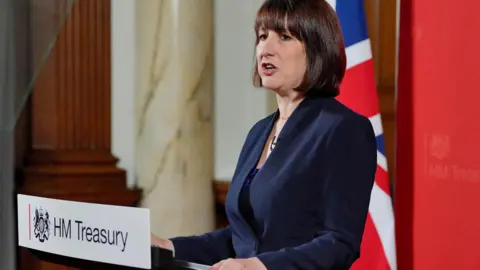ARTICLE AD BOX

 Reuters
Reuters
Chancellor Rachel Reeves says she wants pension schemes to 'fire up the economy'
Chancellor Rachel Reeves wants to “fire up the UK’s economy” by creating a “Canadian-style” pensions model for the UK’s local government retirement schemes, according to the Treasury.
She had a meeting with the so-called “Maple 8”, a group of massive Canadian schemes, to hear how consolidating UK pension funds could boost the economy.
But what does that mean for savers?
The government claims Ms Reeves' pensions review will "boost investment, increase pension pots and tackle waste in the pensions system".
By diversifying investment, the government says the plans could boost pension pots by £11,000 and pour £8bn into the economy.
This includes investments in science, technology and infrastructure.
As part of these plans, the review is also looking at how the Local Government Pensions Scheme (LGPS) can get more from its investments while tackling a £2bn bill for fees.
But because the LGPS is a defined-benefit scheme, where workers' pensions are based on salary and service length, savers will not see any benefit in their pension payments.
What is the Local Government Pension Scheme?
The UK has 86 local government pension schemes, which are mainly paid into by local government workers.
These individually-managed funds are divided by local authority, making it more costly, because each fund is paying its own management and administration fees.
Between them, they have 6.5 million members and manage assets worth £354bn.
The schemes are all part of the Local Government Pension Scheme (LGPS) in England and Wales, which is the seventh-largest in the world, according to the UK government.
Most of its participants are low-paid women.
Under Ms Reeves’ plans, the funds would be consolidated in some way, although at present it is unclear exactly how.
She may ask them to pool their assets and resources, or she may ask them to merge with one another to create a smaller number of larger funds, which would benefit from greater financial firepower and fewer costs.
The LGPS is a defined-benefit scheme, which means that, when it is time to draw their pensions, its savers get an agreed amount based on their salary, no matter what the fund is worth at the time.
That is different to private pension pots, which rise and fall in value depending on how investments perform.
What is the “Canadian model” and why does Ms Reeves believe it can help the UK economy?
The “Maple 8” is a group of vast Canadian pension funds, including the Ontario Teachers Pensions Plan, which manages assets worth C$247.5bn (£141.8bn), and the Canada Pension Plan, whose assets are worth C$409.6bn.
The government wants not only public sector funds to "learn lessons from the Canadian model" but also private sector funds.
While UK pension schemes tend to invest more in assets like equities and bonds, their Canadian rivals focus more on private markets.
The Ontario Teachers Pensions Plan, for example, only has 7% of its assets in listed equities, compared with 60% for traditional pension funds.
Instead, it skews its investments towards private markets, including infrastructure (including a 25% stake in British energy giant SSE) and private equity deals.
This kind of model is not without risk, however.
Canadian pension fund the Ontario Municipal Employees Retirement System is the largest investor in troubled Thames Water, which recently said it had until the end of May next year until its money runs out.
Would consolidation help?
Individually, the UK’s 86 local government pension schemes vary in size, from Greater Manchester’s massive £30bn fund all the way down to several schemes which are “sub-£1bn”, according to Joanne Donnelly, board secretary at the Local Government Pension Scheme Advisory Board.
Running these schemes costs money. Each one must pay administration, governance and management costs, which can build up – last year, those costs increased by £28m.
Like her predecessor, Jeremy Hunt, who also announced plans for a Canadian-style model, Ms Reeves believes consolidation would save money on those costs.
That would in turn “deliver better returns for savers and unlock billions of pounds of investment”.
What is 'pooling'?
In one way, LGPS funds have been consolidating since 2015, when then-chancellor George Osborne set out plans for them to pool resources and assets.
The result was eight “pools” of funds, which are designed to improve economies of scale and improve funds’ ability to invest. These are expected to make savings of £2bn by 2033.
In last year’s autumn statement, Mr Hunt set a deadline to local government pension funds, saying that by March 2025 they must have transferred all their assets into pools.
But Ms Donnelly says in reality, this is unlikely to happen. “It’s nice to have a target,” she says.
There is another option for pension funds: consolidation through a series of mergers.
This would not be the first time that has happened – 400 funds were consolidated into 88 in 1972.
How do the pension funds feel about the prospect of mergers?
“Bigger isn’t always better,” says Ms Donnelly, who adds that some funds prefer independence so they have the option of investing in small projects.
“Some local pension funds want to invest in opportunities closer to home,” she says.
“A lot of those are small – we’re talking a few million. A pool won’t write a cheque for less than £100m – they’re not going to want to look at those opportunities. But they still deliver benefits for the UK in terms of productivity.”
George Graham, the director of the South Yorkshire Pensions Authority, adds that any deal-making would not be popular with funds.
“Clearly, those who are responsible for existing funds don’t want to give up that responsibility,” he says.
“But also, any form of merger in business, is time-consuming and costly.”

 10 months ago
43
10 months ago
43








 English (US) ·
English (US) ·